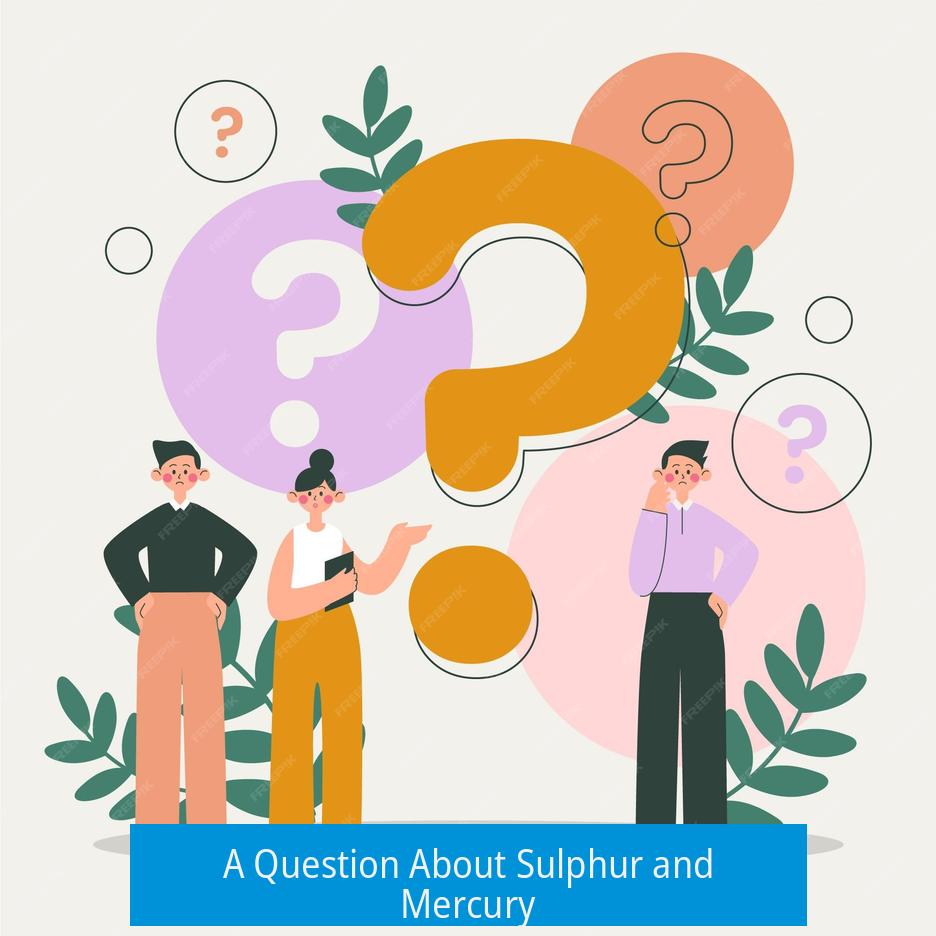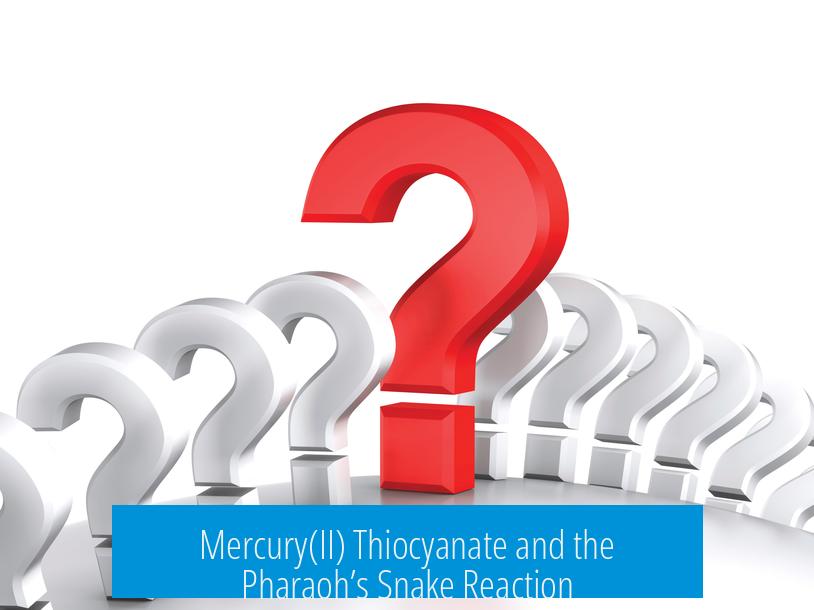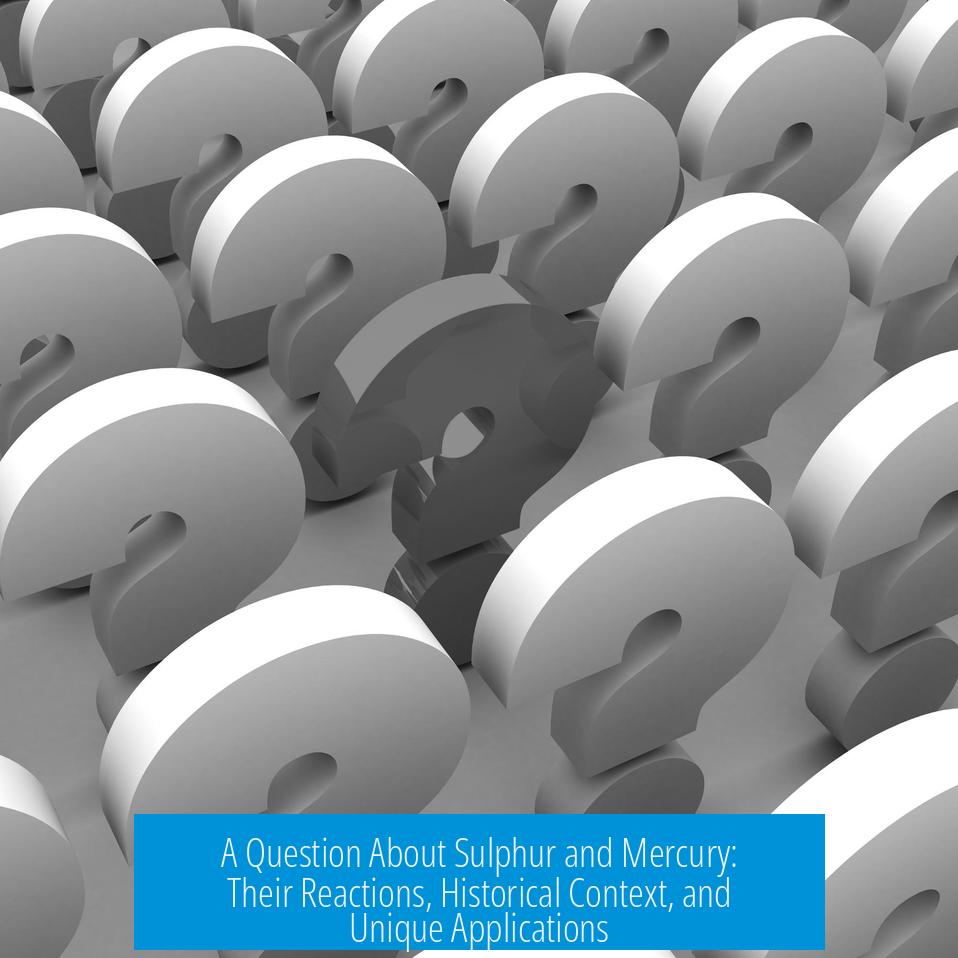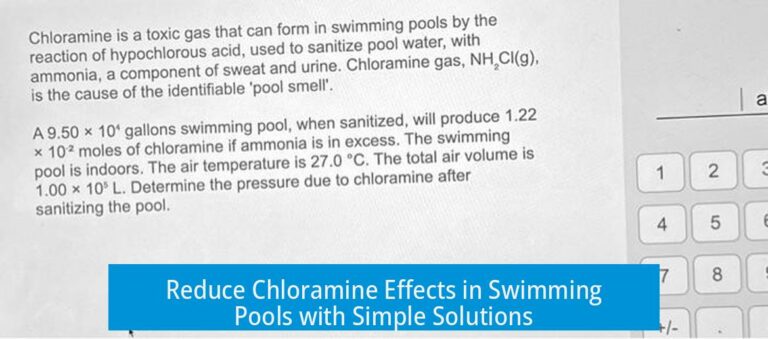A Question About Sulphur and Mercury

Sulphur and mercury react primarily to form mercury sulfide, an important compound with historical and chemical significance. Mercury sulfide exists mainly as cinnabar and meta-cinnabar, pigments once widely used in paints. This reaction and related phenomena also underpin various applications, cleanup methods, and alchemical traditions.
Reaction of Sulfur with Mercury
When sulfur reacts with mercury, it produces mercury sulfide (HgS). This compound is commonly known as cinnabar in its red crystalline form and meta-cinnabar when it appears black. Both these forms represent different crystalline structures known as polymorphs.
- Formation of Meta-cinnabar: At room temperature, mixing elemental sulfur with mercury results in black meta-cinnabar. This is a less stable form.
- Transformation to Cinnabar: Upon heating, meta-cinnabar transforms into the bright red crystalline cinnabar. Achieving this requires controlled heating conditions to maintain color and structure.
Mercury sulfide’s vivid red form was historically significant as a pigment in art and industrial paints. Due to mercury’s toxicity, its use has declined, but cinnabar still remains important industrially and scientifically.
Production of Mosaic Gold Pigment
Sulfur and mercury also play a role in producing mosaic gold pigment, sometimes called “artificial gold.” This pigment forms through a multi-step process involving:
- Reacting mercury and sulfur to form mercury sulfide.
- Adding ammonium chloride and tin.
- Heating the mixture to induce chemical changes that yield a golden-yellow pigment.
This pigment was used historically in art and decoration. The processes used trace back centuries and demonstrate the chemical interplay between sulfur, mercury, and additional metals.
Mercury(II) Thiocyanate and the Pharaoh’s Snake Reaction

An intriguing mercury-sulfur compound is mercury(II) thiocyanate (Hg(SCN)_2). This compound is famous for its dramatic decomposition reaction known as the Pharaoh’s snake or serpent demonstration.
- When ignited, mercury(II) thiocyanate undergoes a thermal decomposition producing a glowing, snake-like carbonaceous ash.
- The reaction showcases rapid gas release and solid residue formation in a visually impressive display.
While historically used in chemical demonstrations, concerns about mercury toxicity have led to safer alternatives. The black snake fireworks, which mimic this reaction without mercury, are widely employed today for educational and entertainment purposes.
Clean-Up of Mercury Spills Using Sulfur
Sulfur’s high affinity for mercury extends to practical applications in spill cleanups. When mercury spills occur, sulfur powders can be applied to bind with mercury and reduce vapor release.
- Sulfur reacts readily with elemental mercury to form solid mercury sulfide, which is less volatile and easier to contain.
- This method improves safety and limits mercury exposure risks during cleanup operations.
Zinc is sometimes also used for mercury binding but should never be combined simultaneously with sulfur due to dangerous reactivity.
Historical and Alchemical Context: Limitations of Two-Element Theory
In alchemical traditions, mercury and sulfur were often regarded as fundamental components of metals and matter. However, modern chemistry shows this binary theory to be an oversimplification.
Several observations challenge the mercury-sulfur view:
- Iron does not form amalgams with mercury. Instead, it forms iron sulfide with sulfur directly.
- Carbon plays an irreplaceable role in metallurgy, particularly in steel production, by altering metal properties. Carbon contains neither sulfur nor mercury.
- Smelting processes require additional elements such as silica (sand) to purify metals by binding impurities.
- Bronze and steel manufacturing excludes mercury and sulfur, since these elements degrade metal quality and evaporate during heating.
Thus, while mercury and sulfur contribute to some mineral and compound formations, actual metallurgical science requires many more elements and processes.
Additional Notes on Mercury and Sulfur Interaction

- Mercury’s interaction with iron is notable in a physics demonstration where an iron nail placed near mercury causes the mercury to oscillate, simulating a “heartbeat.”
- Mercury’s toxicity and unusual properties lead to frequent misconceptions in popular media, though chemical facts remain well established.
Summary of Key Points
- Mercury sulfide (HgS) forms when sulfur reacts with mercury, with two polymorphs: meta-cinnabar (black) and cinnabar (red).
- Mosaic gold pigment is synthesized by combining mercury, sulfur, ammonium chloride, and tin with heat.
- Mercury(II) thiocyanate decomposes dramatically in the Pharaoh’s snake reaction, producing solid “snake” residue and gas.
- Sulfur binds mercury in spill cleanups forming less toxic solid mercury sulfide.
- Two-element (mercury and sulfur) metallurgical theories are outdated; carbon, silica, and other elements critically impact metal production.
- Mercury and sulfur’s roles in mineral chemistry differ from their limited roles in contemporary metallurgy.
A Question About Sulphur and Mercury: Chemistry, History, and Curious Facts
What happens when sulphur meets mercury? They react to form mercury sulfide, also known as cinnabar—the vibrant red pigment that once colored ancient paintings. This simple reaction opens a window into chemistry, history, and even some alchemical myths. Buckle up for a fascinating, often overlooked tale of these two elements!
First off, the reaction itself is less dramatic than you’d imagine. When elemental sulfur and mercury mix, they first create a dull, black compound called meta-cinnabar. It looks boring, nothing fancy—until you add heat. With controlled heating, meta-cinnabar transforms into radiant red cinnabar. This color shift fascinated artists and miners centuries ago, making cinnabar a prized pigment in ancient paint and art.
Did you know that cinnabar is essentially mercury sulfide? It’s the main ore from which mercury was historically extracted. Painters adored it, even if we now know mercury is toxic—back in the day, the charm of bright red was worth the risk.
The Golden Touch: Mosaic Gold Pigment

Speaking of pigments, mercury and sulfur team up in a curious process to produce “mosaic gold,” a golden yellow pigment popular in the Middle Ages for decorative art.
The recipe isn’t just mercury and sulfur. It involves adding ammonium chloride and tin, then heating the mixture. This unique concoction yields a sparkling pigment resembling gold—hence the name.
Imagine alchemists’ delight discovering that combining simple elements with a dash of tin could mimic gold’s gleam!
More Than a Color: The Pharaoh’s Snake Reaction
Mercury and sulfur have some explosive chemistry too. There’s a neat reaction involving mercury (II) thiocyanate, a compound containing both mercury and sulfur, known as the Pharaoh’s Snake or serpent reaction.
This reaction looks like a black snake growing out of a pile of powder when ignited. The result is a fascinating display of expanding carbonaceous ash that resembles a serpent slithering across a table.
Fun fact: Modern “black snake” fireworks mimic this effect but use mercury-free chemicals for safety. Interestingly, you could weave this into a fantasy story as devil-magic, leaving characters spellbound by this “fiery serpent.”
Sulfur to the Rescue: Cleaning Mercury Spills
Here’s a practical use: sulfur’s affinity for mercury is so strong, it helps clean up mercury spills safely. When you scatter sulfur on mercury puddles, it binds with the mercury, forming less toxic compounds that are easier to handle.
However, beware of mixing zinc and sulfur during cleanup. While zinc can also bind mercury, zinc and sulfur should never be combined due to dangerous chemical reactions.
Beyond Two Elements: Historical Misunderstandings and Metallurgy
Alchemists famously believed many things, including that mercury and sulfur were the primary elements shaping metals and life. But this two-element theory fails under modern chemistry’s light.
For example, iron doesn’t form an amalgam (a mercury alloy) easily. When iron meets sulfur, it forms iron sulfide. Yet roasting iron sulfide burns away sulfur, leaving relatively pure iron.
Also, making iron and steel requires more than sulfur and mercury. Carbon is essential for producing steel, often through charcoal. Sand (silica) purifies the metal by gathering impurities. Mercury and sulfur are absent—and even undesirable—in bronze and steel production, as they make metals brittle or volatile.
Curious Side Notes: Mercury’s “Heartbeat” and Movie Magic
In some fun student experiments, placing an iron nail next to mercury makes the mercury surface appear to “beat” like a heartbeat due to complex surface tension and oxidation reactions. No real heart there, just a cool trick.
Finally, movies often dramatize or completely get mercury and sulfur wrong for plot convenience. While that can be entertaining, remember real chemistry is often more subtle and less hollywood-glamorous.
Wrapping It Up
- Mercury and sulfur combine to form mercury sulfide, changing form and color depending on heat.
- This compound served as ancient red pigment cinnabar and gives rise to mosaic gold pigment with additives.
- Mercury (II) thiocyanate’s reaction produces the famous Pharaoh’s Snake effect, stunning to watch.
- Sulfur cleans mercury spills by forming stable compounds, a neat practical use.
- Alchemical ideas about mercury and sulfur are outdated; metallurgy depends on other elements like carbon and silica.
- Mercury’s interaction with iron produces cool effects, but it doesn’t blend easily like some metals.
So, next time you ponder mercury and sulfur—whether in the lab, art history, or fantasy tales—you’ll know there’s more to the story than meets the eye. Chemistry often surprises, blending science and wonder in everyday elements.
What happens when sulfur reacts with mercury?
Sulfur reacts with mercury to form mercury sulfide, also called cinnabar. Initially, it forms black meta-cinnabar. When heated under controlled conditions, it turns into bright red cinnabar.
How is mosaic gold pigment produced using sulfur and mercury?
Mosaic gold pigment is made by adding ammonium chloride and tin to mercury and sulfur, followed by heating. This process transforms the mixture into the pigment known as mosaic gold.
What is the Pharaoh’s snake reaction involving mercury and sulfur?
Mercury (II) thiocyanate decomposes in the Pharaoh’s snake reaction. It creates a snake-like ash display, historically linked to mercury and sulfur compounds. There is a mercury-free version used in fireworks.
Can sulfur be used to clean mercury spills?
Yes, sulfur reacts quickly with mercury, helping to clean spills. Zinc also works, but sulfur and zinc must never be mixed during cleanup.
Do mercury and sulfur alone explain all ancient metal processes?
No. Iron and sulfur create iron sulfide but roasting burns off sulfur. Carbon and silica are essential for making iron and steel. Mercury and sulfur are not involved in making bronze or steel.





Leave a Comment